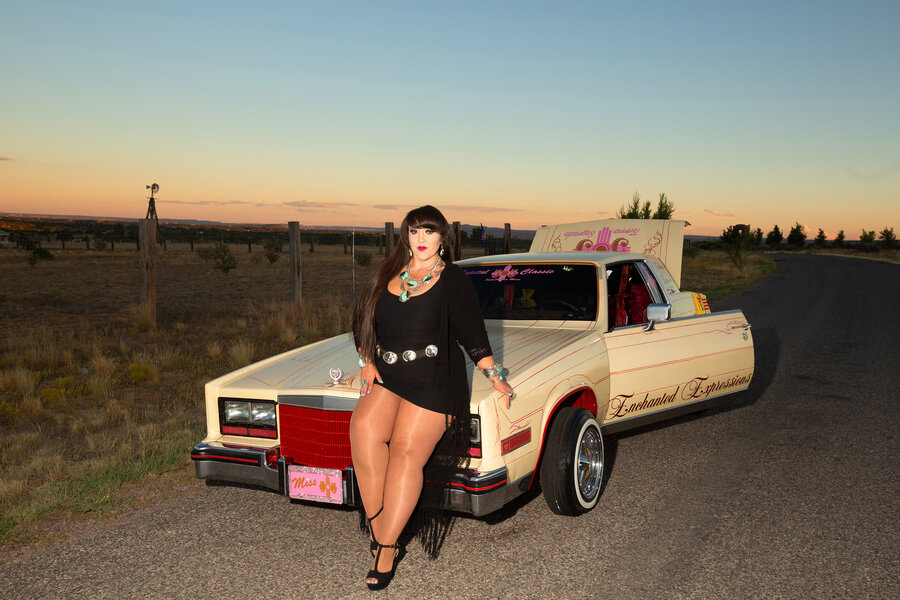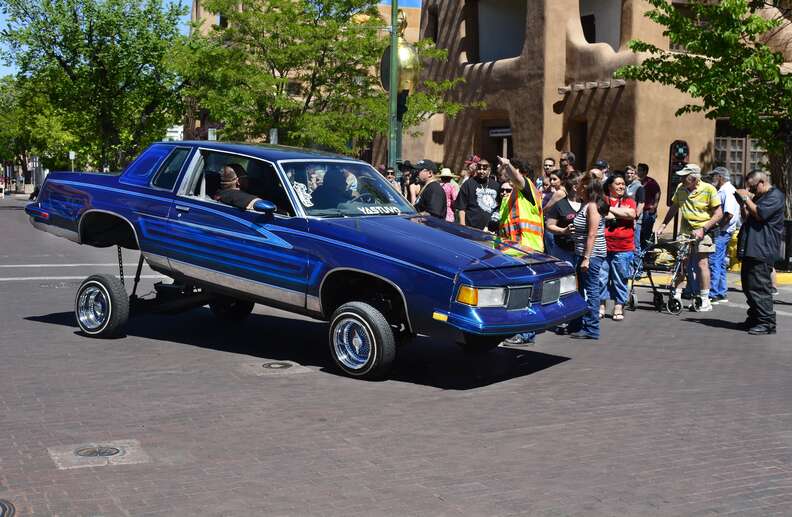New Mexico
Cruising Low ‘n Slow with the Women Shaping New Mexico’s Lowrider Scene

Walk past the Hotel Chimayó, just off the Santa Fe Plaza, and sweep your eyes across my ride: a sleek silver ‘64 Chevy Impala, bathed in the sun, a time capsule commanding the gaze of anyone that lays eyes on her lustrous yet understated carriage. Parked there, she looks refined. Proper, even. But ask nicely, and she’ll drop her back down low, and maybe—with the flip of a switch that controls her hydraulics—bounce it around a little.
She doesn’t have a name, which is unusual for a lowrider, a term that refers both to a car whose suspension has been lowered to inches off the ground, and the person driving it. Most lowriders are personal labors of love, painstakingly put together after spending countless hours and even more cash scavenging for parts. It’s a part of the owner’s family, their story, and the paint job often reflects that, articulating stories of passion, sorrow, pain, and humor, iconographies of faith, struggle, redemption, and community. But my Impala? She’s not only anonymous, but unadorned. She belongs to everyone.
Stay at the Hotel Chimayó and you, too, can ride the passenger seat, rolling past warm, rounded adobe architecture, institutions like the Georgia O’Keeffe Museum, the New Mexico History Museum, and the IAIA Museum of Contemporary Native Arts, plus the vendors selling stunning turquoise pieces around the historic square. The endpoint for the Santa Fe Trail, the Plaza has also been a gathering place for political movements. And it was here in 2016 that Mayor Javier Gonzalez declared May 22 “Lowrider Day.” (“The next best thing to owning a lowrider is admiring someone’s cherry creation,” he said in his proclamation.)
That first Lowrider Day included demos of hoppers, cars outfitted with hydraulics and suspensions capable of not just elevating, leaning, or lowering, but also lifting to towering, near-vertical heights, crashing back down, and bouncing. That last part unfortunately damaged the Plaza’s asphalt, so today’s festivities now include cars suspended halfway up, as if in mid-motion.
“It was only gonna happen for one year,” says Sin Vargas, current Lowrider Day organizer. “But the next year, me, Carlos Munos, and Casey Montoya formed New Mexico Arte de Culture to continue the tradition.”
In addition to Lowrider Day, which changes dates from year to year, you can find car shows online through Vargas’s organization, or just show up at the Plaza on a Friday or Saturday to catch some cruisers in (slow) motion. Come on Good Friday, and it’s mayhem. A lowrider museum is also in the works in Española, New Mexico, but like the cars themselves, it’s taking its time.
That the Heritage Hotel’s whip is a ‘64 Impala isn’t by chance. This is the quintessential lowrider, a 3rd generation model both stretched out and swoopy with an X-type frame that easily lends itself to hydraulic modification. Think of a famous lowrider and you’re probably picturing a ‘64 Impala—including legendary Mexican American lowrider Jesse Valdez’s candy red and pink Gypsy Rose, now in the Petersen Automotive Museum.
But while this car is synonymous with the more recent past, its origins actually date back to Southern California’s post-WWII economic boom. That’s when local vehicle, auto parts, and aircraft manufacturers, among other industries, saw an influx of Chicano war veterans join their ranks, many of them harnessing skills they had learned in the service. And taking their cue from the Anglo-American hot rod craze that swept the country in the 1930s, these newly minted mechanics and machinists decided to put their own twist onto what was becoming a veritable national pastime.
Much like their hot rod-loving counterparts, they wanted their cars flashy. But instead of speed, they went for bajito y suavecito—low and slow. Early lowriders would weigh their cars down with cement or sandbags and cruise the streets as if performing a chromed-out paseo, or stroll, showing off their custom detailing.
Of course, this was the early 1950s, and it wasn’t long before the authorities squashed this overt display of Chicano cultural pride. In 1958, the California Vehicle Code made it illegal to operate any car that’s been modified to sit lower than the bottom of its rims—a law that remains on the books in some cities to this day. Less than a year later, however, a mechanic named Ron Aguirre designed a way to sidestep the restriction. Inspired by the hydraulics planes used for raising and lowering wing flaps, the wily lowrider enthusiast installed switches that easily raised and lowered his car’s chassis, keeping the culture alive through adversity.

We have good ol’ Route 66 to thank for bringing lowriders to northern New Mexico. As New Mexicans set upon Los Angeles utilizing the roadway in search of jobs in the auto industry, lowrider communities sprung up in their wake. The subculture particularly took hold in Chimayó and Española, cities located about 30 miles from Santa Fe and adjacent to the Santa Clara Pueblo, home to the Tewa branch of the Pueblo people. In 1975, Española held New Mexico’s first-ever Lowrider show—the same year War’s very chill, very emblematic “Low Rider” made its debut, a song still played wherever lowriders are found today. Almost 20 years later, MTV declared Española the Lowrider Capital of the World based on lowriders per capita, and in 2018, the city made it official. Here, cars are everything, a fact that very much reflects the struggles of the New Mexicans behind the wheel.
“In my town… cars have been a source of life for people who have been incredibly disenfranchised by multiple layers of colonization”
“In my town, lowriding, and classic and custom cars have been a source of life for people who have been incredibly disenfranchised by multiple layers of colonization,” explains Rose B. Simpson, a mixed-media and performance artist based in Española and hailing from the Santa Clara Pueblo (Kha’po Owingeh).
“I bought my first car when I was 12, drove myself to Driver’s Ed, and got my license at 14,” she continues. “My car was always breaking down because I was broke, but I wanted my freedom, so I worked construction [to] keep my car running and learned to fix it myself. I projected freedom, safety, my aesthetic, and my identity onto my vehicle from a very young age.”
Lowriders have since broken out of the circumstances of their creation. Adopted by hip hop culture in the 1990s, they were amplified by John Singleton’s Boyz in the Hood and songs like Ice Cube’s “It Was A Good Day.” (“If I hit the switch, I can make the ass… drop.”) And for the last few decades, Japan has claimed its own lowriding style. “I was in Japan recently and I was like, ‘These guys are killing it!’” says Simpson. “Which is fascinating because they’re not just making the cars, they’re really embodying that ‘90s lowrider culture that I grew up with and valued.”
To get a feel for the subculture’s deep hold, just have a conversation with Simpson. A Rhode Island School of Design graduate, in her downtime the artist goes hard on heavy metal that rumbles. She’s currently working on her first lowrider, a ‘64 Buick, applying skills she gained while one of the only women enrolled in Northern New Mexico College’s now defunct automotive science program. Describing the lack of women in automotive school, she jokes, “The girl’s bathroom was super, super nice—I should have thrown a cot in there and had a little office because nobody goes in there.”
The Buick may be her first foray into lowriding, but Simpson’s been fixing up cars since that first one in high school. And it’s her stunning, non-lowrider 1985 Chevy El Camino that initially led me to her work. Maria, as she’s called, sports a black-on-black paint job inspired by traditional Tewa pottery made by Maria Martinez of San Ildefonso Pueblo. When Simpson talks about the car she’s affectionate, switching from discussing the technical aspects of buffing paint to describing her as a nurturing vessel in the vein of Nicolas Bouriallard’s Aesthetics of the Everyday.
“She’s a character. I think she’s a piece of me…”
Despite her owner’s dotage, Maria is temperamental, and will sometimes burst into flames if she doesn’t like where she’s being driven. “She’s a character,” says Simpson. “I think she’s a piece of me because, like, if I take her to the grocery store? She’s good, we’re good. But if I take her to a car show, a parade, or she has to go get filmed, she breaks down.”
While all-women car clubs are increasingly popping up around California and muscling their way into New Mexico, lowriding’s machismo culture—like car culture in general—has traditionally been difficult for women to access. When I ask Simpson how she became so confident in her ability to fix up cars, the answer goes back to her mother, a potter.
“My mom built our house, grew all our food, and owns a tractor she doesn’t let anyone drive,” she says. “I never had the feeling that women can’t do something, because of the Indigenous matriarchal women in Santa Clara.”
Though she typically works alone, she has had dreams of an all-women club. But the rising art star with works on display at the Whitney Museum of American Art among other lauded institutions keeps running into one major problem: The women lowriders she knows are just too busy. “I had this idea that I would have a hopper crew,” she says. “That never happened. I was like, ‘Come on, do we have to wait until we’re retired?’ We’re gonna be like these old ladies out there all cackling and shit at the hopping competitions.”
Back at the Hotel Chimayó, you can sip a margarita at the Low ‘n Slow Bar while lowriders congregate under saturated images excerpted from photographer Jack Parsons’ 2005 Low ‘n Slow. A light fixture adorned with glistening hubcaps hangs overhead, below, a diamond-tuck upholstered banquette glitters, orange and red leather doubling as a vintage ride’s bench seat.
But don’t settle for the homage—it’s all about taking one of the real cars out for a spin. One day last spring, I hopped in the hotel’s Impala. My tour guide and driver, Orlie Martinez, turns on War’s “Low Rider” before we set off around the plaza, cruising by windowed storefronts so I can admire our reflection. When Martinez flips a switch, the back drops down, and I can barely see over the dashboard. “I like to roll like this,” he says. “Like a recliner.”
Along the side of the road, tourists pause to ogle. Later, Martinez pulls into a parking lot and, with the help of his car, puts on a show, likening the jerky movements we feel inside to riding a bull. Another switch is flipped and the left side goes up; another, and the right side goes up. He moves it all around and, in lowrider parlance, we’re “dancing.” A crowd gathers and we quickly become the center of attention—and according to Simpson, that’s the whole point.
“It’s soul food, it’s self-love, it’s delicious—it’s when life gets delicious,” says the artist. “Knowing you’re driving something that turns heads, it’s absolutely a beautiful feeling.”
“Oh, you weren’t?” asks Justa Armijo Lovato—a.k.a. Justice Lovato—when I admit that, at first, I wasn’t totally into riding around in Hotel Chimayó’s Impala with all eyes focused on me. “I love it. Heck yeah!”
Granted, everything about Lovato appears destined for the spotlight. From her long silky brown hair to her black dress cinched with a concho belt, bright red lips, and strappy stilettos, she’s not what you’d typically think of when you envision a lowrider. But both Lovato, with her Indigenous, French, and Spanish roots, and her award-winning Cadillac Eldorado, Miss 505, emblazoned with pinstripes, Zia symbols, and the words ‘Tierra Sagrada” (sacred land), are physical embodiments of New Mexico itself.
Like Lovato, Miss 505 glitters: her paint job is a customized cream color with touches of pink and red, her interior plush, with wood paneling and red trim. A logo for Enchanted Expressions, Lovato’s car club, runs along the side, while a Miss 505 decal clings to the back window, creating a magnification effect when the sun streams through. She’s nothing short of a visual feast.
“Throughout our whole state, lowriding has been a reflection of our culture and heritage,” Lovato says. “It’s a representation of our individuality and expression put into our vehicle.”
On her wrists and around her neck are striking turquoise jewelry designed by her friend Adam Fierro, a Native and Spanish jeweler based in Albuquerque. “We are two of a kind, with our Spanish and Native roots and our love and craftsmanship of art,” she says. “His jewelry and my car—it takes individuals of the same mindset to make the endeavor successful.”
Slow-rolling metal is in Lovato’s blood. Her mom Julia, a seventh-generation Santa Fean, had an affinity for cars; her dad Rick is a mechanic. In high school, a boy named Julian Lion turned her head with his lowrider Chevy S10 truck. They’ll be married 25 years this year.
“I was 14, he was 16, and he was in a car club,” she says, recalling the man—and pickup—that changed her life. “That was the very first lowrider to actually take [me on] a ride and really draw me into wanting to build my own.”
She graduated in 2002, and after falling in love with the 1985 Caddy driven by Robert De Niro in Casino, her parents gifted her the all-original 1985 Cadillac Eldorado that would eventually become Miss 505. After a five-year stint in the Navy learning aviation mechanics, she and Julian started building her up.
By then, Lovato was fully invested in lowriding. But when she tried joining a few car clubs, she found that the members were often more interested in what her husband had to say. And so, in 2010, she started her own. Enchanted Expressions is open to everyone, regardless of vehicle type or the person behind the wheel. Today there are 25 members, eight of which are women, including Lovato’s mother.
And she didn’t stop there. It was Justice-style ingenuity that got Miss 505 into 2017’s Lowriders, Hoppers, and Hot Rods: Car Culture of Northern New Mexico at the New Mexico History Museum, cementing her owner’s place in history as the first woman lowrider exhibited in New Mexico history.
These days, the car and driver pair’s reputation precedes them. They serve as ambassadors for lowrider culture in local schools, and the Taos Sheriff’s Department has dubbed her La Reina del Norte (a.k.a. Queen of the North), a title she carries proudly. Walk into the Taos Inn and—if it’s not on loan to a gallery—you’ll see a painting of Lovato and her car by acclaimed artist Tera Muskrat. In Lovato’s home, there’s a room stacked with almost 80 awards. “My whole living room is full because I have so many of them, and it’s such a high achievement for me, especially the Best in Show Awards,” she says. “I don’t want to tuck them away like some people do in their garage—I want to see them every day.”
Awards won’t be Lovato’s only lowriding legacy. Her club continues to inspire future generations. There’s one young enthusiast who routinely swings by to fix up her own sweet ride. “She’s working on a little electric scooter,” she says. “It is so cute.”
Want more Thrillist? Follow us on Instagram, TikTok, Twitter, Facebook, Pinterest, and YouTube.

New Mexico
Human plague case reported in Bernalillo County, second in state this year
New Mexico
Playoff-Race closing: New Mexico United takes on Colorado Springs Switchbacks – New Mexico United

New Mexico United travels to Colorado Springs this Wednesday for a Western Conference showdown in the USL Championship playoff race.
The Black & Yellow currently sit fifth in the USL Championship, fighting for the postseason and will look to keep building momentum as the regular season winds down. With a few matches remaining, every point matters, and United will aim to deliver a strong midweek performance on the road.
Wednesday’s contest will be the third meeting between United and the Switchbacks FC this year. In their previous two encounters, United secured a home victory in June during the Jagermeister cup, and drew in the first encounter in June. This clash gives United a chance to claim the season series and strengthen their hold on a playoff spot.
Standout Performers: Archimède and Keller
Forward Luther Archimède continues to be a spark for United’s attack, bringing energy, pace, and aerial ability. His late equalizing goal against Monterey Bay highlighted his gift for delivering in clutch moments. The sixth man has contributed two goals in six games off the bench, proving his talent.
Defender Kipp Keller has been a rock at the back for United since arriving, with his calm composure, strength, and sharp defensive instincts. His leadership on the backline and ability to read the game have been crucial in keeping opponents on their toes. His presence will be needed to keep Colorado’s attackers in check.
Milestones in Sight: Tambakis
Goalkeeper Alex Tambakis is on the verge of making USL Championship history, needing just one more clean sheet to become the league’s all-time leader. After recording his 58th career shutout recently—tying the current record held by Evan Newton—Tambakis will have the opportunity to stand alone at the top when United takes the field Wednesday night in Colorado.
About Colorado Springs
The Switchbacks have fought their way into playoff contention with their mix of grit and attacking ability. On the Attacking side Marco Micaletto has been getting it done, leading the team in goals with six. On the back line, Matthew Mahoney provides a physical and clinical presence, leading the Switchbacks in almost every defensive category this season.
Looking Ahead
Following Wednesday’s trip to Colorado, New Mexico United return home hosting Lexington SC on Sunday at 4 PM MT. With the postseason right around the corner, the Black & Yellow remain focused on collecting crucial points and carrying the momentum into October.
Get tickets HERE
New Mexico
Nature: Forest regrowth in New Mexico

-

 Finance5 days ago
Finance5 days agoReimagining Finance: Derek Kudsee on Coda’s AI-Powered Future
-

 Business1 week ago
Business1 week agoHow Nexstar’s Proposed TV Merger Is Tied to Jimmy Kimmel’s Suspension
-
North Dakota5 days ago
Board approves Brent Sanford as new ‘commissioner’ of North Dakota University System
-
World1 week ago
Russian jets enter Estonia's airspace in latest test for NATO
-

 Crypto4 days ago
Crypto4 days agoTexas brothers charged in cryptocurrency kidnapping, robbery in MN
-

 World4 days ago
World4 days agoSyria’s new president takes center stage at UNGA as concerns linger over terrorist past
-

 Technology4 days ago
Technology4 days agoThese earbuds include a tiny wired microphone you can hold
-

 Culture4 days ago
Culture4 days agoTest Your Memory of These Classic Books for Young Readers





















